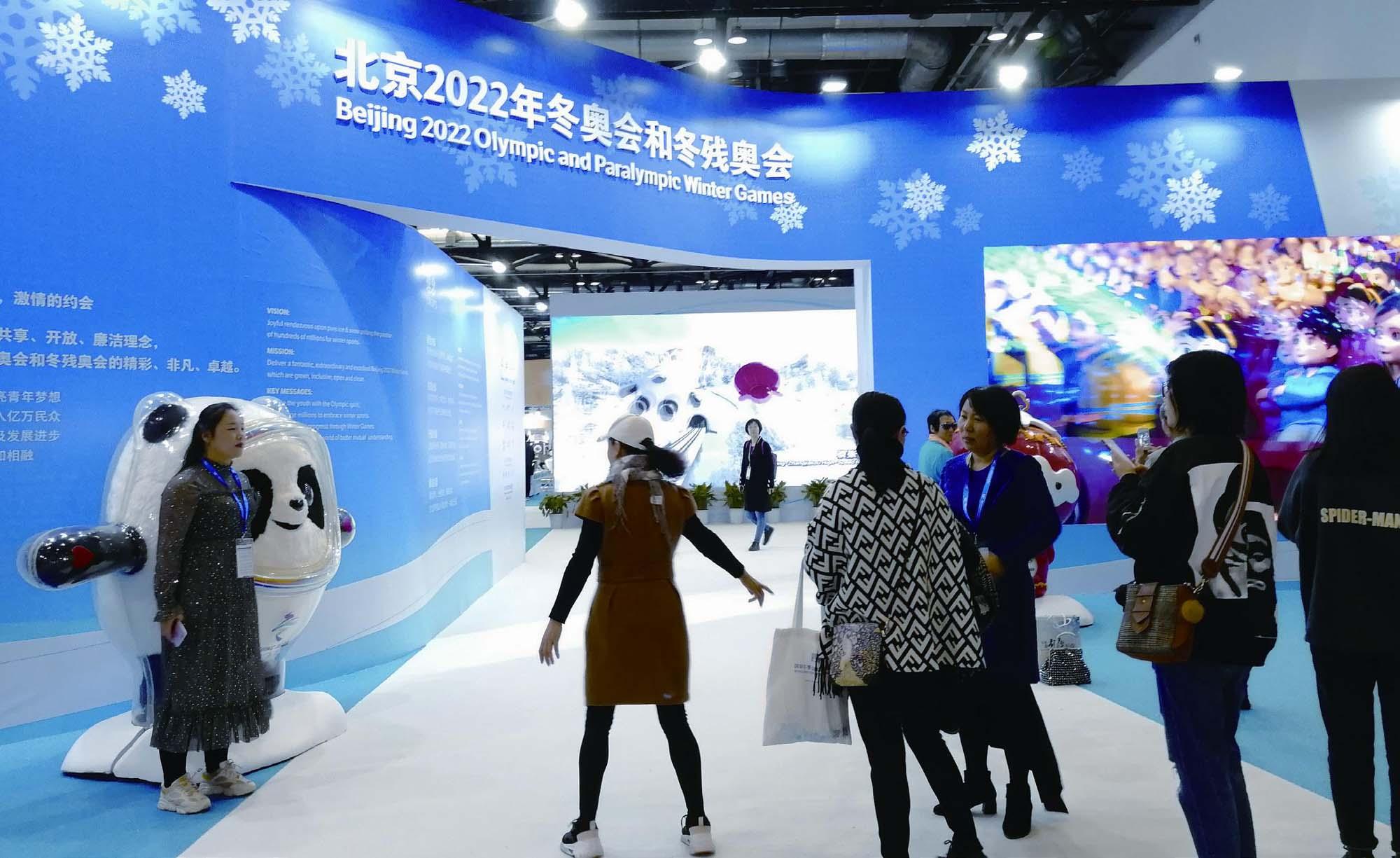ICE AND SNOW TIME
2019-11-11ByWangHairong
By Wang Hairong

Rovaniemi, a city in Finland located at the Arctic Circle, sent its most famous resident to Beijing to attend the 2019 World Winter Sports (Beijing) Expo. Santa Claus was one of the busiest people during the event held from October 17-20. Donning his signature red cap and magnificent in his white beard, he introduced his town to visitors.
“In my hometown, it is already winter. The temperature has already dropped to minus 5 degrees Celsius,” he said, “The ground is covered with snow and 2-3 cm of ice.”
Rovaniemi is one of the most famous winter sports resorts in Finland and boasts a wide variety of top quality training facilities.“Santa is a big supporter of winter sports, perhaps because winter is truly his season of operation and the elves need to keep fit to be able to deliver the gifts to all children around the world,” read a brochure at the Finland booth at the expo.
Santa was in good company at the expo, which drew more than 240 guest speakers to its forums, as well as exhibitors representing some 600 brands from home and abroad and many visitors. Inaugurated in 2016, the expo has been held in Beijing for three consecutive years, with the aim of promoting winter sports in China and developing the ice and snow industry in the country and the world.
Hot winter sports
The expo was launched after Beijing won the bid in 2015 to host the 2022 Olympic and Paralympic Winter Games. The capital will cohost the games with Zhangjiakou City in Hebei Province, which lies about 200 km away. During the bid, China set the goal to motivate 300 million people to engage in winter sports.
According to a research report on the development of Chinas snow and ice industry released at the expo on October 17, the bid has spurred the development of winter sports in China. The report was presented by Zhang Li, Vice President of International Data Group (China), which co-organized the expo with the Beijing Olympic City Development Association (BODA).
It also revealed impressive growth in winter sports facilities, showing that as of the end of June, there were 388 indoor skating rinks in China, up 16.2 percent year on year, nearly half of which were located in Beijing and Shanghai municipalities as well as Heilongjiang, Guangdong, Jiangsu and Shandong provinces.
During the past three years, the number of ski fields has maintained steady growth, up from 607 in 2016 to 761 as of June. During the 2018-19 snow season, Chinese residents made approximately 23.45 million visits to ski fields all over the country, up 21.5 percent from the previous season, the report said.
It also predicted that the value of Chinas ice and snow industry will reach 600 billion yuan ($84.8 billion) by 2020, and 1 trillion yuan ($141.4 billion) by 2025. In comparison, the total value of Chinas sports industry in 2025 is predicted to be about 5 trillion yuan($707 billion). The report also said that in the next three to five years, the number of skiers in China will approximate 55 million.
Although north China has relatively rich ice and snow resources, Zhang said that recently, winter sports have developed faster in the southern part of the country.
A visitor to the expo from Taizhou City of east Chinas Zhejiang Province inquired about purchasing equipment for preparing slopes in ski fields along with machines to produce artificial snow in indoor environments. He told Beijing Review that an indoor ski field covering 20,000 square meters is under construction in his hometown.
In recent years, the Shennongjia Zhonghe International Ski Resort located in Shennongjia Mountains of Hubei Province in central China has seen an increasing number of tourists, Wang Zuhong, Assistant General Manager of Hubei Shennongjia Tourism Co. Ltd., told Beijing Review. He said that the resort received approximately 120,000 visits last year and expects to get about 150,000 this year.
Shennongjia is a picturesque mountain range that is home to some rare flora and fauna. It has an average altitude of 1,700 meters, with the highest peak rising more than 3,100 meters above sea level and covered with snow for more than three months a year. “The right latitude, temperature, humidity and altitude make the quality of the snow close to that of the Alps,” Liu Qijun, head of Shennongjia Forestry District, said, adding that it is an ideal place for ice and snow sports.
“Nowadays, tourists from all over the country and the world come here to enjoy the rime and the snow, ski and taste delicious food,” Liu told the media in March. For four consecutive years, the local skiing market has surged at a rate of 80 percent. With five ski resorts, the district received 300,000 visits during the 2018-19 winter season, Liu said, adding that as of March, Hubei had 16 ski fields, with four more under construction.
Although the growth is impressive, there are also challenges, Liu said, pointing out that the hardware and software of ski slopes, especially small ones, still need to be improved, while efforts should be made to turn first-time skiers into regular ones because currently only one out of every 100 first-time skiers will become a regular skier. He suggested combining winter sports with ecological tourism and fitness, along with teaching students winter sports at school.
Vibrant cooperation
In addition to stimulating snow and ice sports and the industry, the upcoming Beijing Olympic Winter Games has also brought China and countries with strong winter sports cultures closer.
“The winter sports expo is a platform for exchanges and cooperation between China and foreign countries,” said Liu Jingmin, BODA Executive Vice Chairman, at the opening ceremony. It is gathering resources from the world and injecting strong momentum into the development of Chinas winter sports and ice and snow industry to contribute to the success of the upcoming Olympic Winter Games, he added.
This year marks the China-Finland Year of Winter Sports. Finland served as the guest country of honor at this years expo.
“The Peoples Republic of China (PRC) and Finland have a long history in sports cooperation,” said Hanna Kosonen, Finnish Minister of Science and Culture, at the opening ceremony. “In 1950, China sent a team to the Helsinki 1952 Olympic Summer Games. This was the first time the PRC took part in the Olympics.”
She said that in the run-up to the Beijing Winter Olympics, the two countries have decided to deepen cooperation in winter sports. “Currently, this cooperation plays an important role in our bilateral relations,” she said.
The Finnish Pavilion at the expo featured nearly 40 key winter sports companies and organizations, said Jarno Syrjala, Ambassador of Finland to China, adding that the bilateral cooperation in winter sports will go beyond the games.
In addition, the country attracts more than just Chinese winter sports fans. “Last year, about 400,000 Chinese tourists visited Finland, half in winter and half in summer; this year, the number will grow 15 percent,”said Virpi Aittokoski, a project manager with Visit Finland, a sports travel agency.
Chinese tourists can live like locals, thanks to a mobile app developed by the Tencent Group, which helps them overcome the language barrier and access local services, Rebekka Mikkola, a consultant to the city of Helsinki, told Beijing Review. She grew up in China, has worked in China for over 10 years and speaks Chinese as fluently as a native. “We will continue to improve our services to make traveling more convenient for Chinese tourists,” she said.
In addition to Finland, representatives from about 20 other countries also attended the expo. Signe Brudeset, Ambassador of Norway to China, spoke at a forum and introduced cooperation between China and her country in winter sports training and other related areas, saying that some Chinese athletes are being trained in Norway in fields such as cross-country skiing and ski jumping.
Some Norwegian companies exhibited their products at the expo. Terje Smevold, an employee of Brav Norway AS, told Beijing Review that this is his first time in China because the company sees opportunities here, and he believes he will come more often in the future. He brought Swix ski wax and other products to the expo, saying that his company occupies more than 60 percent of the global ski wax market.
Emanuele de Maigret, head of the Economic and Commercial Office at the Italian Embassy in Beijing, said that cooperation between China and Italy has been carried out at both national and local levels. Some Italian companies have participated in the construction of Winter Olympic venues in China. He invited Chinese tourists to experience winter sports in Italy.
Michael Mayr, Sales Director of TechnoAlpin Asia, said, “Its an honor for us to join this winter sports boom.” His company, based in Italy, has been chosen as a supplier for the Beijing Olympic Winter Games, providing snow and ice making equipment and automatic systems.
Jan Dijkema, President of the International Skating Union, and Kate Caithness, President of the World Curling Federation, also spoke at the opening ceremony of the expo. They highlighted the friendly exchanges between China and their respective organizations and expressed wishes for further cooperation.
